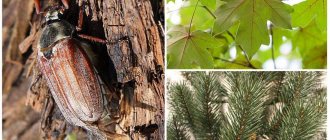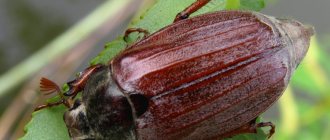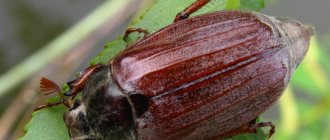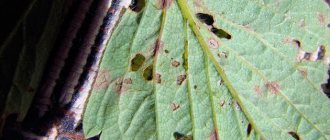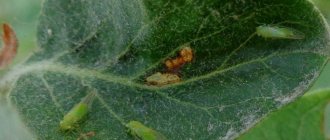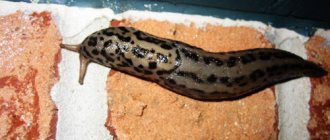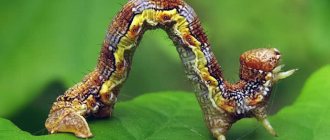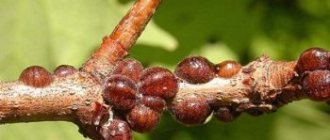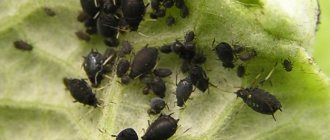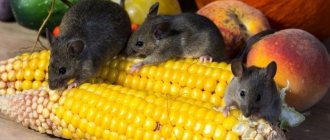The cockchafer is a dangerous pest of green plants. It causes double harm not only to vegetable and garden plants, but also to tree crops in gardens, forests, and parks. Adult individuals of the cockchafer can be classified as gourmets. They prefer the leaves of oak, birch, maple, poplar, linden, and rowan to other forest and park species. They are not interested in herbaceous weeds and cultivated plants. Sometimes in May you can see short garlands of chafers on these trees. The life span of an adult beetle is quite short and it does not have time to cause significant harm, but its larvae, with a multi-year development cycle, are less picky in their diet and are able to quickly destroy significant areas occupied by agricultural crops.
May beetle, or May beetle (Melolontha). © Anthony White
Distribution of the cockchafer
May beetle , or May beetle (Melolontha) is an interesting buzzer for children and one of the most dangerous pests due to its omnivorous nature and distribution area. Currently, out of 24 (according to other sources - 74) species, 9 are widespread in Russia. May beetles have everywhere populated the forest-steppe and forest zones of Europe and Asia. In the Russian Federation they are found everywhere from the southern outskirts to the Siberian taiga. The distribution area of the pests covers almost the entire territory of the European part, including the regions of Central Russia. In the Asian part it is distributed to Kamchatka. Found everywhere in the Caucasus and Transcaucasia.
Danger level of the cockchafer
The beetle's danger level is quite high. Presence of 1 larva per 1 sq. m area is the threshold of harmfulness of the cockchafer. A survey of forest and park lands, garden plantings in some regions recorded the presence of 2 - 3, and near forest belts - up to 20 or more larvae per square meter. m.
Under favorable conditions, there is a rapid increase in the number of the pest and a period begins, after about 20-25 years, of mass flight, which lasts up to 3-4 years. An approximately 10-year break is necessary for cockchafers to intensify reproduction before the start of the next mass flight with the capture of new areas.
Reasons for the appearance of the pest on the site
May beetles prefer sandy soils ; they are less common in heavy clay areas. It is more convenient for females to lay eggs in uncompacted soil. They love well-groomed and cultivated gardens and vegetable gardens ; here they have favorable conditions - nutritious soil, many plants, compost and humus heaps .
The life activity of the larvae is affected by temperature and humidity. High humidity is detrimental to them, and when the temperature rises above 25°C, they sink to great depths. During spring cold snaps and recurrent frosts, the cockchafers freeze and may die.
Pest numbers are reduced by exposure to fungi, bacteria and parasitic nematodes.
What crops does the cockchafer damage?
Adult chafers appear in early May when warm weather sets in. During this period, they cause harm by feeding on young leaves and flowers of all garden, park and forest plants. Cold weather causes imago torpor and even death when spring frosts return. Adults are most harmed in the spring when they emerge from the pupa. The main concern of an adult insect is to leave offspring. For 1-2 months a year, adult female cockchafers feed intensively and lay eggs.
4-6 weeks after the imago emerges, the next generation of larvae hatches from the eggs, and the larvae of previous years of hatching are activated. They live in the soil for up to 4 years, going through 6 stages of maturation. They constantly migrate in the vertical soil horizon. In winter they go to the lower horizons up to 50 cm, and in the spring they return to the root layer with the soil warming up to +10..+15 °C. The larvae of the May beetle throughout the entire period of their life, except for the pupal stage and the period of hibernation, constantly gnaw on everything that is in the soil. Unlike adult May beetles, they gnaw at the roots of weeds, vegetable and garden plants, mature garden and forest trees, berry beds, shrubs and other types of plants.
The larvae gnaw the roots of strawberries/strawberries, black and other types of currants. Especially a lot of them gather at the roots of apple and cherry trees. In parks and forest edges, cockchafer larvae settle at the roots of aspen, birch, cedar, spruce and other plants. Observations have established that a 3-year-old larva is capable of destroying the root system of a 2-year-old pine in 1 day, and a 2-year-old larva will feed on the roots of the tree for a whole week. There is currently a 10-year hiatus in flight. New cockchafer larvae hatch from the laid eggs, previously born ones grow up, and the larvae reproduce intensively in soil conditions.
May beetle larva. © a-evans
Description of the cockchafer
The cockchafer is a major pest. The body length of an adult insect reaches 3.5-4.0 cm. The body of the beetle is barrel-shaped, elongated at the rear into a process, black or brownish-brown, sometimes reddish in color. The body is covered with small hairs. They are longer on the head and soft underwings. The beetle is dense due to its strong outer chitinous skeleton. Female chafers are different from males. Sexual dimorphism upon external examination is manifested in the length of the antennae: in females they are short, in males they are long, resembling a curved club in shape.
What does it eat?
What do cockchafers eat? The larvae eat various roots , and the adults eat foliage .
Is the cockchafer a predator or not? Despite its impressive size, exceeding most other insects, the cockchafer poses no danger to them at all, eating exclusively plant foods .
May beetle pupa - photo:
Development cycle and reproduction of cockchafers
The development cycle of the cockchafer lasts 4-5 years. In the second half of May, adult sexually mature females appear, whose life is limited to mating and laying eggs (50-80 pieces) in the upper 15-20 cm layer of soil. After laying, the females die. After 1.0-1.5 months, white larvae hatch. Small and weak, in the first year they remain at the site of hatching and feed mainly on soil organic matter (humus). Starting from the second year, they spread in the soil, occupying new areas.
The cockchafer larva lives and feeds in the soil for 3-4 years. During this time, it goes through several stages of development, then, approximately in the middle of summer of the 4th year, it enters the stationary pupa stage. An adult beetle emerges from the pupa - an imago, which only appears on the surface of the earth in the spring, begins to feed intensively and starts a new development cycle. At the same time, a huge number of larvae of different ages remain in the soil. Young females replenish the supply of eggs, annually increasing the generation of larvae by 70-200 pieces each.
Signs of plant damage by the cockchafer
Adult beetles eat leaf blades, buds, partially ovaries and young needles. When damaged by larvae, without visible external causes, plants begin to wither, lag behind in development and die. Herbaceous plants are easily pulled out of the soil. Dead seedlings must be carefully dug up and the soil checked for the presence of larvae. They are usually large, with a dark head, curled into a "C" shape. On the underside of the segmented body there are 3 pairs of thoracic and 5 pairs of abdominal legs. If larvae are detected, it is necessary to urgently take measures to protect against the pest.
Development cycle of the cockchafer. Illustration from volume II of the encyclopedia “Fauna of Germany” by Edmund Reitter. 1908
Kinds
Khrushchev beetle - what is it? Khrushch is the second name of this beetle. When we say May beetle, we mean any type of May beetle . In other words, May beetle (or May beetle) is a generalized name for all members of the family. The nickname was given to these insects so as not to be confused with other beetles that are not part of the May beetle family.
White
White Khrushchev - photo:
A variety whose body is covered with numerous chalky scales, making the beetle appear white. Although in fact, the body has the usual brown color. In males, scales are located much more often than in females, so it is easy to distinguish him by his lighter color tone . There are long, densely arranged hairs on the chest.
It belongs to large specimens, reaching a length of 3.5 cm. It lives in Central Asia and the steppe zone of Russia. Very common in Crimea and the Sea of Azov. Prefers sandy areas , living in the dunes of sea coasts and desert sands. Life expectancy - 3 years .
The larva feeds on many crops , including strawberries, potatoes, fruit trees and vineyards, actively eating their roots.
Oriental or wild chestnut
An adult beetle is relatively small - up to 2.9 cm. The body is elliptical-oblong, convex. The color is dark, predominantly brown with a reddish tint . The shine is not pronounced, the head is decorated with many specks.
The larva is much larger, its average size is 6.5 cm. The head is orange, the body is white, curved in the shape of the letter C. It is very voracious and polyphagous . It feeds on the roots of vegetable, field and garden crops, especially young seedlings. Often operates in nurseries and greenhouses.
Adult beetles eat the leaves of most trees , including conifers. Life cycle duration is 5 years.
Eastern view of the May Khrushchev - photo:
West
Outwardly similar to the Eastern Khrushchev, but differs in larger size , growing up to 3.2 cm in length. The body is stocky, very convex and wide at the sides. The shape is oval, elongated downwards. Coloration can vary from light chestnut to almost black or dark brown . There are light triangular spots on the sides of the abdominal segments.
On the front back there are grayish-yellow hairs; on the elytra they are sparse and lighter. The larva is a dirty yellowish hue, the head is brown, the jaws are brownish-yellow. It grows from 4.4 to 6.6 cm in length.
It feeds on the roots of trees, root crops, herbaceous plants and grain crops. Prefers young tree seedlings in nurseries, strawberries, sugar beets and potatoes.
Adults gnaw the leaves of shrubs and trees - beech, walnut, oak, alder, hazel, poplar, linden, willow, plum, pear, cherry and apple tree. It eats coniferous trees only in the absence of more tasty species.
The life cycle is 3-4 years. Distributed throughout almost the entire territory of Europe, including the European part of the CIS countries.
Western cockchafer - photo:
June or summer rootworm
The smallest species, reaching only 2 cm in length. The body is brown, densely strewn with yellowish hairs. The elytra are shiny, pale yellow. The length of the larva is no more than 4.5 cm.
They do not tolerate dampness , so they live mainly in sandy lands.
The color is dirty white, the head is brown. The larva is voracious and practically omnivorous ; when infested en masse, it can cause significant damage to plantings, especially in nurseries. The life span is 2-3 years.
Summer root gnawer - photo:
How to deal with the cockchafer?
An important agrotechnical measure is the collection and destruction of cockchafer larvae during autumn and spring digging of the site. The optimal temperature for larvae is +24..+26 °C. They have not yet gone deeper for hibernation, but in the spring they already move closer to the roots of plants in the upper 10-20 cm layer of soil.
May beetles have natural enemies (entomophages) that feed on insects. To attract them to the garden, you can sow dill, cumin, fennel, anise, and coriander in different parts of the plot. Sunflower, phacelia and other nectar-bearing plants are attractive to entomophages.
If it is impossible to systematically care for the garden, it is better to sod it. Female cockchafers (like winter cutworms) will not be able to penetrate the turf into the soil, which means they will not lay eggs.
If permanent sodding is not provided, insecticidal plants can be used. Thus, the larvae of the cockchafer cannot tolerate high nitrogen content in the soil and leave such places. You can sow white clover, peas, beans, legumes and other crops that are nitrogen fixers under the tree trunks, and in the fall you can incorporate them into the soil as green fertilizer when digging.
May beetles and their larvae cannot tolerate the smell and secretions of lupine and mustard. The larvae die of starvation, since there are no weeds around the lupine to feed on, and the beetles immediately fly away from these hated plants. Mustard is an excellent green fertilizer; when incorporated into the soil, it will contribute to the death of the larvae.
The larvae of the cockchafer cannot tolerate chloride compounds. If larvae are found in the soil, you can switch to applying chlorine-containing fertilizers or, when digging, add a little bleach randomly.
Breeding birds and hedgehogs on the site, which actively destroy adult cockchafers and their larvae. You can hang traps with bait.
At the end of April - May, the emerging May beetles, at a temperature not higher than +12..+15 ° C, sit in a pre-dawn daze on the branches of trees. At this time they are shaken off and collected.
In the garden, green manure from mustard, white clover, peas and other crops, especially cruciferous crops, should be systematically used. Plant tall plants (potatoes, eggplants, corn, etc.) in white clover. The nodule nitrogen on clover roots will drive out the May beetle larvae and serve as green fertilizer for cultivated plants. During the summer (as green manure), clover is mowed between the rows.
Accumulation of cockchafer larvae under the turf. © Pitchcare
Prevention
- The simplest agrotechnical method against the pest is spring digging of the soil in the beds and in the tree trunks . At this time, the larvae are easy to spot. Tillage is mandatory for virgin areas. On such lands there is always a large concentration of the pest.
- The vegetable garden and garden are kept clean throughout the season and weeds, especially wheatgrass, are destroyed . It attracts not only wireworms, but also cockchafer larvae.
- Mulching the soil is useful . A loose layer of crushed straw and wood shavings prevents females from laying eggs.
- The pest has many natural enemies , including various birds, hedgehogs, ground beetles, and moles. To attract birds, you can install several birdhouses on the site. They will save plants from damage by both adult beetles and larvae.
If you do not hesitate and use the whole range of measures, then all attacks of the cockchafer and larvae can be successfully repelled and make your area unattractive to the pest.
Chemical measures to combat the cockchafer
Naturally, the use of chemicals in a summer cottage is not encouraged, but for those who like to quickly destroy all living things, we can recommend the following chemicals for destroying cockchafer larvae.
Pochin and Zemlin are insecticides of contact and intestinal action. When shallowly incorporated into the soil, they begin to actively influence the larvae within 24 hours, especially young ones that feed on humus. For 10 sq. m area, add 15-20 g of powder or granules of a chemical preparation. These preparations can be applied to the hole when planting potatoes and other plants.
Aktara , Bazudin , Vallar are contact-intestinal insecticides that kill soil pests. They are used mainly for treating the roots of planted plants, as well as surface application to the soil in the form of solutions or a dry form of the drug.
When using chemicals, be sure to follow the instructions for dilution and application. When using soil-acting insecticides, there is no need to treat the above-ground mass of plants (except for special instructions in the recommendations).
Antichrusch is a drug with a long period of influence on the pest. Before use, the suspension concentrate is diluted to a working solution according to practical instructions for vegetable crops, seedlings and shrubs. The roots of the plants are soaked in the solution and the working solution is poured under the root.
Among chemical agents, you can use a solution of ammonia water for future plantings of strawberries/strawberries. Dissolve 200 g of ammonium nitrate in 10 liters of water per 1 sq. m area 3-4 months before planting seedlings. This technique will get rid of beetles and their larvae for many years.
Khrushchi especially love the tender roots of strawberries. For preventive purposes, you can add a solution of ammonia (a tablespoon/bucket of water) under the strawberry roots.
May beetles, or May beetles (Melolontha). © Jude Lock
Folk remedies
No matter how effective chemical or biological agents against Khrushchev are, folk methods of dealing with unwanted guests in the garden will never lose their relevance:
- An effective folk remedy is to collect cockchafers from bushes and trees. Beetles are usually collected in the morning and evening in calm weather. The advantage of the method is that the insects can be fed to birds or used as fishing bait. Otherwise, they should be burned or trampled.
- If you have chickens or other poultry, you can use this as a weapon against pests. Having released them into an area where there is no risk of damage to the crop, they will quickly pull out and eat many beetle larvae.
- Dissolve 6 grams of potassium permanganate in 10 liters of water. Water the suspected habitats of the cockchafer with the solution. After a while this will scare them away.
- Table salt is also a good method of prevention and control. Pour a glass of regular salt onto a bucket of water. Watering beetles with this solution also gives results.
Biological measures of protection against the cockchafer
At home, it is better to use appropriate biological products for all garden, berry, vegetable and other crops and flower beds. They purposefully kill pests without harming the health of people and animals.
One such biological product is Nemabact . The biological product, being introduced into the body of the cockchafer larva, kills the pest within 3 days. The concentrate is diluted in a ratio of 1:100. Work with the drug at an air temperature not lower than +25..+26 °C. Apply to moist soil after watering or before watering.
Aktofit , Boverin , Fitoverm , developed on the basis of soil Effective Microorganisms (EM microflora), effectively destroy the larvae of the cockchafer
Before using biological products, be sure to study the recommendations. Self-dilution with increasing concentration of the working solution will not have a negative effect on pests, but may cause plant disease.
The larva of the cockchafer gnaws at the root of the plant. © Meret Huber
Folk techniques for fighting the cockchafer
Experienced gardeners recommend an infusion of onion peels in a ratio of 100 g/10 l of water, leave for a week and treat the soil under the plants. To spray plants, dilute the solution again in a 1:1 ratio.
If 1-2 larvae or adult beetles were found in the spring, then it is necessary to add (1%) to the soil and treat the plants (0.1%) with a solution of potassium permanganate .
When cultivating the soil in spring, you can add freshly slaked lime or a chlorine-containing preparation . The smell of lime and chlorine will repel beetles trying to lay eggs.
A solution of ammonia will drive away the beetles . Use a solution of 20 ml per 10 liters of water and spray the plants in the fall. The beetles will leave without forming oviposition on the planting.
